|
|
|
Sort Order |
|
|
|
Items / Page
|
|
|
|
|
|
|
| Srl | Item |
| 1 |
ID:
165878
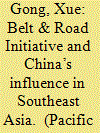

|
|
|
|
|
| Summary/Abstract |
The Belt and Road Initiative (BRI), since its inception in late 2013, has drawn
tremendous global attention. The views of political leaders, business people,
the media, and analysts on the prospect of the BRI are ostensibly polarized.
One group asserts that the BRI will dramatically increase Beijing’s global influence, particularly in China’s neighborhood. Another group surmises that the
BRI is expected to fail because of insurmountable challenges and is expected
to fail. This article joins the debate by exploring the impact of the BRI on
Southeast Asia’s regional order. The author holds a middle-ground position
and argues that the actual impact of the BRI should neither be easily dismissed nor overestimated. More likely, through the BRI, China’s influence in
Southeast Asia will increase but not to the extent of forging a Sinocentric
order in the region. This can be explained by three major factors: (a) the
responses of Association of Southeast Asian Nations (ASEAN) and its member
states toward the BRI, (b) the effects of alternative infrastructure initiatives
proposed by other major powers in Southeast Asia, and (c) China’s questionable ability to deliver its BRI promises.
|
|
|
|
|
|
|
|
|
|
|
|
|
|
|
|
| 2 |
ID:
165875
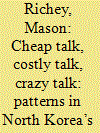

|
|
|
|
|
| Summary/Abstract |
This article examines the patterns in the Democratic People’s Republic of Korea’s (North Korea’s) use of hostile rhetoric in its internationally-directed messaging. The article first places North Korea’s belligerent rhetoric in the context of that country’s capacity to threaten the US and its Northeast Asian allies; indeed many analysts worry that Pyongyang’s rhetoric represents a conflict escalation risk or even a casus belli. Following this, the article discusses the common explanations – irrationality/incompetence, lack of audience costs, inter alia – for why the North Korean regime employs such hostile rhetoric, and finds these explanations wrong or misleading. The main analysis section describes the results of a study of 10 years of English-language propaganda published by the KCNA (North Korea’s state news agency). A multiple regression model is used to test the relationship between North Korea’s hostile rhetoric and a set of independent variables. The statistical tests indicate a mixed correlation of North Korean rhetoric to the independent variables. One major finding is that there is no correlation between hostile North Korean rhetoric and the country’s kinetic provocations. The conclusion discusses the role that North Korea’s rhetoric plays within the country’s larger adversarial relationship to the US, South Korea, and Japan.
|
|
|
|
|
|
|
|
|
|
|
|
|
|
|
|
| 3 |
ID:
165877
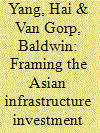

|
|
|
|
|
| Summary/Abstract |
This qualitative study is designed to identify the frames in the debate on the Asian Infrastructure Investment Bank (AIIB) and analyze the framing by different actors. To that end, it drew insights from framing theory and conducted an in-depth inductive frame analysis based on a representative sample of official documents and news articles. 14 frames (7 frames and 7 counterframes) emerged therefrom. They represent the AIIB debate along six dimensions: China vis-à-vis AIIB (Tool, We’re all equal), AIIB for members (Boon, Bane), AIIB versus status quo (Rival, Complement, Winds of change), standards (Made in China, Qualified yes, Up to par), prospects (Off to a good start, Not all roses), and external reactions (Game, Much ado about nothing). Building on the frames identified, the study went further to show how political actors applied frames in their (self-)justificatory discourse, and how media enriched the debate by bringing in frames absent from the official discussions in the political circle. The findings herein not only attest to the contested nature of the AIIB and the diverging framing by different actors, but shed some light on the wider discussions on China’s evolving relations with the incumbent global system and established powers.
|
|
|
|
|
|
|
|
|
|
|
|
|
|
|
|
| 4 |
ID:
165874
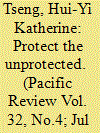

|
|
|
|
|
| Summary/Abstract |
Escalating tensions in the Peninsula may force voluminous North Koreans to leave the country, although relevant information is limited. China has refused to grant North Korean escapees the refugee status, because the main reason of their departure, economic hardship, is not prescribed in conventional refugee definition. The Bangkok Principles provide principal guidance to Asia’s refugee issues, whereto its non-legally binding framework helps facilitate the fledgling regional efforts and still-developing states’ wills. Yet, China’s insistence in distinguishing economic hardship from political causes reifies its overt cautions to the rapidly evolving refugee causes, and an outright rejection to the indiscriminate humanitarian nature of refugee protection. Another reason is China’s ‘Asian Values’ approach to human right, seeing various aspects of human right as separable. To grant refugees only partial rights would appear theoretically unsound, and blatantly contradicting its integral human-right essence. Realistically, China has only limited refugee reception experiences. Its relevant domestic mechanism is under-developed, whereby positive public opinions cannot be effectively remoulded. China also worries about the unwanted international attentions and entailed geopolitical implications, which imply denunciation of Pyongyang’s governance performance by formally identifying these escapees, refugees. Current dramatic changes in inter-Korean relations urge China to take swift, expedient, and substantive actions.
|
|
|
|
|
|
|
|
|
|
|
|
|
|
|
|
| 5 |
ID:
165880


|
|
|
|
|
| Summary/Abstract |
Despite the continuous risk posed by transnational militancy to Chinese interests in Pakistan, China and Pakistan have improved their cooperation on matters of security and economy in recent years. While transnational militancy in a state dyad is known to increase the potential for conflict, it may also spur interstate cooperation on counter-militancy operations under certain conditions. This article examines the sources of the increase in Sino-Pakistani cooperation in fighting transnational militancy. Pakistan was in the early 2000s the country where the Chinese experienced most militant attacks resulting in the cancellation of Chinese projects in Pakistan despite the dyad’s professed all-weather friendship. More than a decade later, the Chinese are back with a prospected $62 billion in investments in the China–Pakistan economic corridor (CPEC). This overarching incentive has altered the challenge of transnational militancy to their mutual relations from a mostly negative, to a more constructive one requiring costly cooperation. In a quest to secure a continuing relationship in a hazardous landscape, the state dyad is attempting to roll out a concerted security strategy involving the army, navy, paramilitary forces and private security companies. A mix of domestic policies of both states, their foreign policies and the nature of threat posed by the militants facilitates this cooperation.
|
|
|
|
|
|
|
|
|
|
|
|
|
|
|
|
| 6 |
ID:
165879
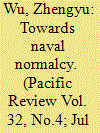

|
|
|
|
|
| Summary/Abstract |
On May 26th, 2015, China published its 10th Defense White Paper which integrated 'open seas protection', along with 'offshore waters defense', into its naval strategy. This shift in naval strategy, albeit largely anticipated, raises a series of important questions about China's maritime ambitions. This article seeks to analyze the causes, nature and challenges of China's latest shift in naval strategy, and its implications for Sino-US maritime relations. The article argues that China's latest shift in naval strategy is a logical corollary of the tension between China's expanding global interests and its asymmetric approach to sea power, and the Belt and Road Initiative (BRI) provides the necessary stimulus and justification for such a shift. China's new naval strategy, the paper contends, denotes that it will develop a Mahanian blue-water navy and a basic network of overseas bases in the years ahead. Those two developments are expected to pose a series of significant challenges for China's foreign policy. The article argues that China's new naval strategy presents both challenges and opportunities for China and the world. To accomplish 'open seas protection', China will probably have to modify its policies on a range of issues, and moderate its competitive stance in the near seas. Although China's new naval strategy need not be interpreted in a competitive framework, it does present China with a stark choice: either it pursues more friendly attitudes towards its maritime ambitions by modifying its current policy, or it will be increasingly confronted by a coalition of hostile states.
|
|
|
|
|
|
|
|
|
|
|
|
|
|
|
|
| 7 |
ID:
165876


|
|
|
|
|
| Summary/Abstract |
This exploratory article seeks to analyze the nature and impact of one of the main democracy promoters in Malaysia i.e. the United States (US). The US is a promoter that is often being alleged with interfering with Malaysian domestic affairs, especially since the sacking of former Deputy Prime Minister, Anwar Ibrahim in 1998. This article argues that the US democracy promotion in Malaysia can be conceptualized under the framework of a concurrent democracy assistance strategy. This is due to the fact that while the US is supporting the non-regime compatible program, it is also concurrently channeling bigger aid for regime-compatible program to Malaysia from 1999–2015. The improvement of diplomatic ties between both countries since post-Mahathir era and the prioritization of security issues have led to a more engaging conduct of democracy promotion. Despite the US continuous funding of non-regime-compatible programs through non-state actors, this approach was nevertheless balanced by cordial relations at the state level. Nevertheless, the effect of US democracy assistance and promotion on Malaysia’s democratic development has been minimal, reinforcing the views on the difficulty to promote democracy in a semi-authoritarian regime.
|
|
|
|
|
|
|
|
|
|
|
|
|
|
|
|
| 8 |
ID:
165873
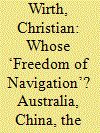

|
|
|
|
|
| Summary/Abstract |
The so-called freedom of navigation through the Malacca straits and the South China Sea, some of the world’s busiest trade routes, has long been of concern to scholars and practitioners of international politics in the region. Increasing tensions around territorial disputes recently propelled the issue to the forefront of global foreign and security policy making. Yet, despite the frequent invocation of threats to the ‘freedom of navigation’ for the justification of military measures to protect the ‘liberal rules-based order’, the substance of this rule or norm remains ambiguous and the nature of the threatened order unclear. Located at the confluence of the Indian and Pacific Oceans, Australian discourses represent a suitable case for clarifying both. Starting from the original provisions on navigational regimes in international law, this study analyses the meanings that officials, think tank analysts and academics have been attributing to the freedom of navigation and contextualize them in the evolving debate about order. Focusing on political rather than legal discourses, it finds that concerns with the freedom of navigation are largely unrelated to the safety of maritime transport. Instead, they serve as proxy for an increasingly static imagination of international order – written backward in time – to be secured.
|
|
|
|
|
|
|
|
|
|
|
|
|
|
|
|
|
|
|
|
|